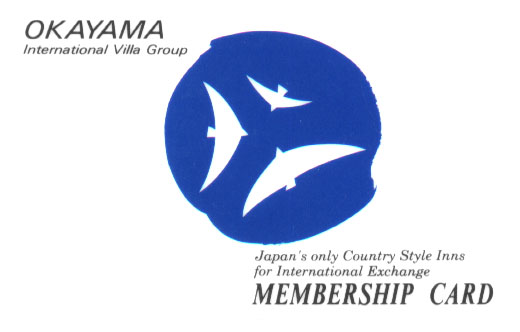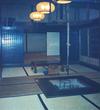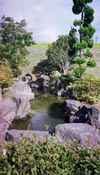The Hattoji International Villa
|
| The Okayama prefectural government decided to create a series
of low-cost places for international visitors to stay in order to try and
encourage tourism in Okayama (I saw many signs of government spending in
Okayama prefecture -- the concept of pork barrel clearly plays on both sides
of the Pacific). Thus, they created the Okayama
International Villa Group. |
 |
|
There are six villas in the group, but the two that sounded most appealling
to me were Hattoji and Koshihata. I couldn't get to Koshihata for various
logistical reasons, but I spent three wonderful evenings at the Hattoji
villa.
|
The Hattoji villa is set amidst the rice fields of Hattoji,
and is one of the more prominent landmarks in town -- the bus driver wil
know exactly where it is. On my arrival, he was nice enough to drive straight
up to it's driveway -- but remember where the bus stop is, that's where
he picks you up! |
 |
| |
|
|
| The villa itself is a beautifully preserved traditional Japanese thatch-roof
farmhouse -- that's right, there's nothing between you and the rain except
for rice straw! The farmhouse was originally in another village, but was
moved to this site. It was used in filming the 1985 Japanese movie "kuroi
ame" (black rain). |
 |
However, the more important movie reference is My Neighbor Totoro -- if
you've seen this wonderful piece of Japanese animation, you already know
what this house is like. It was the house from Totoro -- down to
the horizontal sliding door leading to an attic full of dust bunnies! The
outer walls are shoji screens on the inside of a narrow porch, with sliding
glass doors at the outer edge. |
 |
When I arrived, there was no one at the Villa. Within an hour or so, however,
Maruo-san, the caretaker, showed up. She took me on a whirlwind tour of
the Villa, giving me rapid-fire instructions in Japanese for tending the
irori, the traditional fireplace around which the living room is centered,
and which is the only heat in the villa (there is a modern kitchen and bathroom
as well as a traditional iron kettle Japanese bath). |
 |
| The picture at right is looking through the living room
into the bedrooms beyond. As you can see, there are no hallways; the rooms
are simply separated from each other by sliding screens of either shoji
or wood. The floors were all tatami, and as always with tatami, that meant
shoes were not allowed in the villa (since I was already inside when Maruo-san
got there, it's a good thing I had figured it out). This picture and the
one of my bedroom are taken with natural light, emphasizing what a wonderful
place the house is to be in. |
 |
Above is my room at the villa, complete with the traditional
alcove for displaying a scroll and a ikebana arrangement (as also found
in the ryokan at Kinosaki). Originally I was going
to use the bedroom next to this on the other side of the house, but Maruo-san
started talking about that. Due to her patience, I eventually understood
why she recommended I move: There are lots of wild boar in the woods around
Hattoji even today, and they think a ripe field of rice makes a great meal.
So, at night, the rice farmers put out very bright yellow flashing lights
(which I saw for my whole stay there). The room I was originally going to
use faced a rice field with one of these lights in it, and since there's
only a shoji screen and some glass between you and it, it's kinda distracting.
Happily, there were no flashers on this side of the Villa, and I didn't
run into any wild boars in the woods either. |
| |
|
|
| Maruo-san took about forty-five minutes to explain the running
of the villa to me, then left. She was the only person I saw inside the
villa while I was there. Although the guest book suggested there had been
other visitors within about two weeks, there was no one else there at all
in mid-September. That was typical of anywhere resort- or tourist-like that
I went on this trip, even though the weather was beautiful; several people
told me that the Japanese end summer September 1, no matter what the weather
is like (this can't be explained by the school calendar the way it can here,
since Japanese kids are in school almost the entire summer). |
| |
| I hope these photos give you a little sense of the Hattoji
Villa -- it was an incredibly wonderful place to stay, and an incredibly
cheap one as well -- although it was supposed to be ¥3000 per night
for single occupancy, for some reason it was only ¥2000 when I got there.
Compared to lodging anywhere, that's a steal -- and this is an amazing place
to be in as well. |
 |
When I went exploring the grounds of the Villa the next day, I found this
pretty flowing-water pond (manmade). There are also bikes in the garage
for your use, but like most bikes in Japan they're total beaters -- I wouldn't
trust them on any real road! It's a shame, by the way, that's it hard to
rent excellent bikes in Japan -- rural Japan would be a wonderful place
for bicycle touring. |
| |
Update in July 2007: Believe it or not, the International
Villas arestill only ¥3000 per night. There's a great article
about the villa on Shiraishi Island on SeekJapan. |
|
| By the way, the logistics of the Hattoji Villa
aren't made perfectly clear on the OIV website -- there are no restaurants
or grocery stores in Hattoji most of the year, and you need to bring your
own food in to cook. The nearest grocery store is down in Yoshinaga, and
because the trusty Bizen bus only runs a couple times a day, it'll burn
most of a day to go get food. So remember to bring it on up! The grocery
store in Yoshinaga very convienent to the train station and bus stop,
so it is practical to simply shop there after getting off the train and
before catching the bus -- but be sure to leave a little time! |






